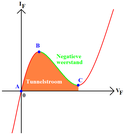Tunneldiode
En tunneldiode eller Esaki-diode er en diode som på en lille del af sin overføringsfunktion har en negativ differentiel modstand. Leo Esaki opdagede diodetypen i 1957, heraf navnet Esaki-diode. [2]
Forspændes en tunneldiode til at arbejde, hvor den har negativ modstandskarakteristik, vil den f.eks. kunne ophæve en svingningskreds tabsmodstand og derved forstærke, så resultatet er en tunneldiode oscillator[3][4], en superregenerative modtager - eller tunneldiode forstærker.[5][6]
Kilder/henvisninger
| Wikimedia Commons har medier relateret til: |
- ^ rf-microwave.com: Datablad 1N3716
- ^ jspsusa.org: The Global Reach of Japanese Science Speaker: Leo Esaki Citat: "...This environment stimulated me, encouraged me, and eventually lead me to my thesis work of the Esaki Tunnel Diode in 1957...the root of this development was the tunnel diode, which I made in 1957..."
- ^ clarku.edu: Tunnel Diode Oscillator Essentials. Chuck Agosta - Clark University Citat: "...The tunnel diode oscillator (TDO) is a highly stable self resonating oscillator system that we use to measure rf penetration depth in conducting, superconducting, and magnetic materials...", backup
- ^ 1999, arxiv.org: Radio-frequency impedance measurements using a tunnel-diode oscillator (TDO)technique, backup
- ^ C. T. Munsterman. Tunnel-Diode Microwave Amplifiers, backup
- ^ Aertech Industries, Brooke Clarke: Tunnel Diode Amplifiers Citat: "...The TD amplifier combines a TD operating in the negative resistance region with a matching circuit and a circulator to separate the incident and reflected waves. Since the isolation of a single junction circulator is around 20 dB the gain of each stage needs to be less than that to prevent oscillations...", backup
Se også
- Lambda-diode
- Backward-diode
- Diode
- Josephson tunneldiode
- Resonanstunneldiode, RTD
- Kvantemekanisk tunnelering
Eksterne henvisninger
- 11 February 2004, isa.org: New, faster diode leads to next era of electronics Citat: "...Under the rules of quantum physics, an electron on one side of a barrier can travel through to the other side, "which would be like a tennis ball coming out the other side of a brick wall," said Paul Berger of Ohio State University in Columbus, Ohio..."
- By Nyle Steiner K7NS 2001. Hjemmelavede dimser med negativ modstandskarakteristikker:
- Ge Tunnel Diode Manual 1961
|
Medier brugt på denne side
(c) Zen-in at the English Wikipedia, CC BY-SA 3.0
8-12 GHz tunnel diode amplifier manufactured by Aertech, used in aerospace applications. This is a two-stage amplifier. Each stage consists of a reflection amplifier made of a biased negative resistance tunnel diode and a circulator, a three-port ferrite device that separates the output signal from the input, and matching networks. The input signal to each device is applied to port 1 at bottom of its heat sink, and is transferred to port 2 at right, connected to the tunnel diode mounted in the heat sink. The output from the tunnel diode emerges from port 3 at the top of the device. The circulator provides about 20dB isolation of the output from the input, so the gain of each stage must be limited below this value to prevent feedback, requiring 2 or more stages to achieve significant amplification. More information on these amplifiers is on Brooke Clarks Aertech website
1N3716 tunnel diode made by GE, with 0.1" jumper in the background for scale








